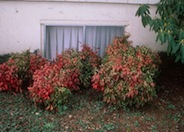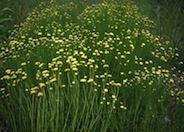
Common name:Lamb's Ears
Botanical name:Stachys byzantina 'Silver Carpet'
This variety of Lamb's Ear does not produce flowers worthy of having. It is grown for the beautiful and soft silver grey foliage.

Common name:Butterfly-Iris, Fortnight Lily
Botanical name:Dietes grandiflora
This clumping evergreen iris bears tall, narrow leaves to 30" tall and white flowers marked purple in the center on stalks to 3' tall. This variety has stiffer, darker foiliage than the bicolor form. It requires sun to part shade with little or no summer watering when established. -Monterey Bay Nursery

Common name:Dwarf Heavenly Bamboo
Botanical name:Nandina domestica 'Compacta'
The dwarf heavenly bamboo is an evergreen shrub that grows 4-5 ft. high. It has green and bronze foliage that turns red in the winter. It is resistant to oak root fungus and hardy to 10 degrees F. The dwarf heavenly bamboo is native to California and is drought tolerant. -Cornflower Farms

Common name:Yellow Cotton
Botanical name:Santolina pinnata
Yellow Cotton is a low shrub to about 2' and a little bit wider. It has dense rich green foliage and yellow flowers. It creates a distinct Mediterranean look.

Common name:Swan Hill Fruitless Olive
Botanical name:Olea europaea 'Swan Hill'
Standing 25-30' high, a flower deformity makes this tree fruitless.

Common name:Japanese Maple
Botanical name:Acer palmatum
This magnificent plant can used as a small tree or shrub. It is deciduous with graceful leaves which have a scarlet color in spring as it leafs out. They turn orange or yellow in fall. It is slow growing to 20', and requires shelter from hot winds.
The leaves of this tree are small, light green in color, and deply lobed. It should also be noted that the tree remains spectacular throughout all seasons. Second picture by Steve Mullany.
Healthy soil is the cornerstone of a vibrant landscape. It provides oxygen and nutrients vital to plant growth and sustenance. It provides protection from the sun and stability for root systems.
Click in the green box for more information
Designer:
Photographer: GardenSoft
Maintain a two to four inch layer of mulch on the soil surface to reduce weeds, infiltrate rain water, and reduce compaction.
Mulching and adding compost to soil can minimize evaporation and help soil absorb and store water.
Develop healthy soil for plants that are vigorous and naturally pest-resistant.